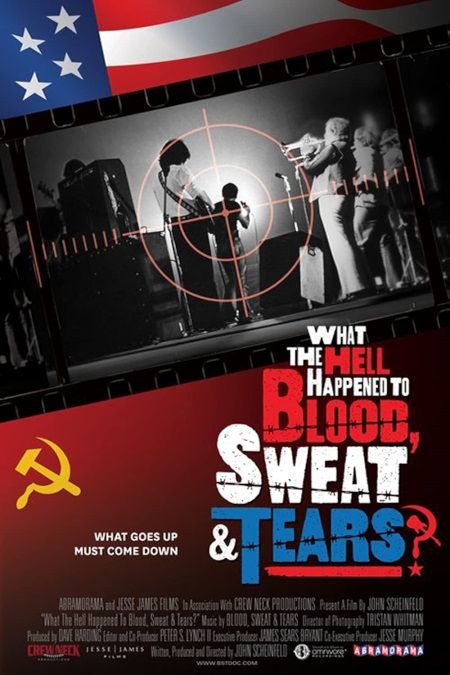Last night I went to see the new documentary, What the Hell Happened to Blood, Sweat & Tears? at the cinema. After the credits finished and the lights came up, I remarked to my companion that this was the most of anything Blood, Sweat & Tears I've ever encountered in my life.
For me, they've just always been this fairly popular R&B/rock band who did "Spinning Wheel". But, in the late 60's, they were immensely popular. I had no idea their second album won the Grammy for Album of the Year in 1970 and was #1 in the charts for several weeks. I knew that they played at Woodstock but was blissfully unaware of 3 consecutive hit singles.
What the Hell Happened to Blood, Sweat & Tears? opens by introducing us to the band and to the social chaos of the late 1960's, especially the war in Vietnam and how it was dividing Americans. The movie portrays the band, excepting one member, as being largely apolitical, however. In June 1970, BS&T became the first American rock band to perform behind The Iron Curtain when they embarked on a short tour that took them to Yugoslavia, Romania and Poland. The kicker is that the tour was sponsored by the U.S. State Department.
There might have been some goodwill mixed in but the tour was largely a propaganda effort. The U.S. government wanted to give the Eastern Bloc audiences a taste of America, a taste of freedom. The tour was to be filmed creating even more ammo to use against the Soviet clients. In the end, however, the footage shot on the tour was not used by the State Department and secreted away. Apparently most of it remains locked away to this day with the exception of an hour's worth or so which was discovered quite recently.
We get to see that there was much more than "Spinning Wheel" to BS&T. The performances we witness are powerful and kinetic with singer David Clayton-Thomas really belting it out as drummer Bobby Colomby pounds the skins. Really, everyone in the band simply rock and the concert footage features tight, energetic performances.
The audiences caught the vibe and responded rapturously to the previously forbidden sounds of rock music. A few fellows who were at these shows talked of how they made them feel. That sense of the music offering a feeling of freedom, a sense of escape, and that there was something better to be had in life. However, some listeners responded too rapturously. Other scenes show Romanian police using dogs to disperse the audience at one show. This naturally caught the attention of some hall monitor apparatchiks who deemed the ecstatic responses unacceptable and endeavored to get the band to tone things down. It didn't work.
Upon returning to the States, the band talked about what they saw over there. We get press conference footage in which some of them speak about how the tour changed them and their views. Witnessing life behind The Iron Curtain and meeting some of the people gave them a more nuanced view of the world, including an appreciation for the United States, despite its flaws.
These views coupled with the band's association with the State Department equaled heresy, for some. They had sold out to the Man and were rejected and ridiculed by the Left. Abbie Hoffman and the Yippies are mentioned in the movie including being responsible for a bag of horse shit being thrown onstage at their first concert on U.S. soil after returning from behind The Iron Curtain.
The movie claims that the band's decline in popularity was due to their government sponsored tour. For their part, the band claims they were between a rock and a hard place. Singer David Clayton-Thomas is Canadian and was being threatened with deportation at the time. Doing the tour was the only way for them to have kept him in the country and in the band.
Despite the brouhaha, the band's next album, 1971's B, S & T; 4, did reach #10, although the singles never reached the heights of previous ones. It'd be interesting to actually read reviews of the album from the time to get an idea of critical opinion. Was the music appreciably different from the stuff on their previous two albums?
Was their fall from the good graces of fans a fait accompli? Or would having consented to be in the Woodstock movie helped ameliorate some of the criticism?
In searching for chart info, I found this ditty in what I think is the first edition of The Illustrated Encyclopedia of Rock (1976):
"BS&T's later albums, though not as pretentious as the second, have been about equal blends of cold technique and ersatz emotion, this disintegratory trend reaching a nadir with the more posturingly meaningless performances of vocalist David Clayton-Thomas."
Ouch!
I don't recall anything in the movie directly comparing what happened to BS&T to today's Cancel Culture but it's hard not to make that comparison. The movie, however, seems to be less of a critique and more of a warning that movements will spawn purity police and eventually eat their own. More importantly, What the Hell Happened to Blood, Sweat & Tears? really just wanted to tell a good story above social criticism.
I really enjoyed What the Hell Happened to Blood, Sweat & Tears?. I learned about a band that I was previously all but totally ignorant of. It gave the context of the times and illuminated a little known chapter in the history of rock music.
On a complete tangent, I went looking for Blood, Sweat & Tears shows and only found a few. To wit:
Newport Jazz Festival, 4 July 1969
Cafe Au Go Go (basement of the New Andy Warhol Garrick Theatre), 6 September 1968
Winterland, San Francisco, 10 March 1968
Kenmore Square, Boston, MA, 23 February 1968
Jahrhunderthalle, Frankfurt, West Germany, 26 May 1973

No comments:
Post a Comment